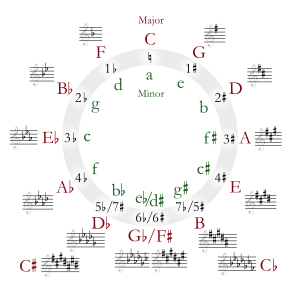B major facts for kids
 |
||
| Relative key | G♯ minor | |
|---|---|---|
| Parallel key | B minor | |
| Notes in this scale | ||
| B, C♯, D♯, E, F♯, G♯, A♯, B | ||
B major is a major scale that starts on the note B. A scale is a set of musical notes ordered by pitch. This particular scale has five sharps in its key signature.
Every major key has a relative minor key. For B major, its relative minor is G-sharp minor. It also has a parallel minor, which is B minor. An enharmonic equivalent means it sounds the same but is written differently; for B major, this is C-flat major.
Contents
What is B Major?
A key signature tells you which notes to play as sharps or flats. The B major key signature has five sharps. These sharps are F-sharp, C-sharp, G-sharp, D-sharp, and A-sharp.
Key Signature on the Staff
When you see the key signature for B major, the sharps are placed on the staff in a specific order. This order helps musicians quickly know which notes are changed. For example, in the treble clef, the A-sharp is usually placed in a way that avoids using extra lines, called ledger lines. This makes it easier to sight-read the music.
Playing B Major on Instruments
Even though B major has many sharps, it can be quite comfortable to play on some instruments.
B Major on the Piano
The famous composer Frédéric Chopin actually thought B major was one of the easiest scales to play on the piano! He believed the black keys fit well with the natural position of a pianist's fingers. Because of this, he often taught B major as the first scale to his new piano students. He even thought C major, which has no sharps or flats, was harder to play and taught it last.
B Major on Other Instruments
While B major is good for keyboard instruments and guitar, other keys might be easier for different instruments. For example, the key of C-flat major is often simpler for writing music for the harp. This is because C-flat major is considered the harp's "home key."
| Diatonic Scales and Keys | |||||||||||||||||||||||||||||||||||||||||||||||||||||||
|---|---|---|---|---|---|---|---|---|---|---|---|---|---|---|---|---|---|---|---|---|---|---|---|---|---|---|---|---|---|---|---|---|---|---|---|---|---|---|---|---|---|---|---|---|---|---|---|---|---|---|---|---|---|---|---|
|
|||||||||||||||||||||||||||||||||||||||||||||||||||||||
| The table shows the number of sharps or flats in each scale. Minor scales are written in lower case. | |||||||||||||||||||||||||||||||||||||||||||||||||||||||
See also
 In Spanish: Si mayor para niños
In Spanish: Si mayor para niños


